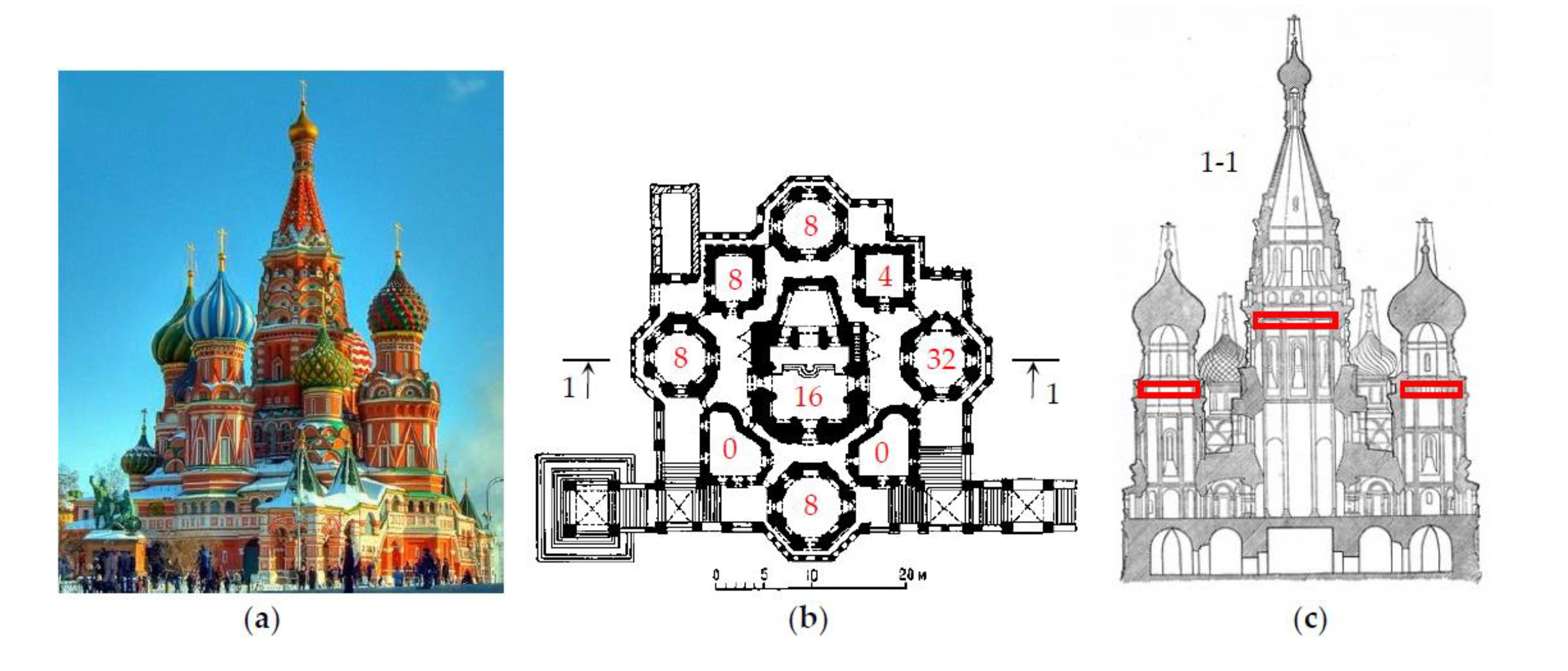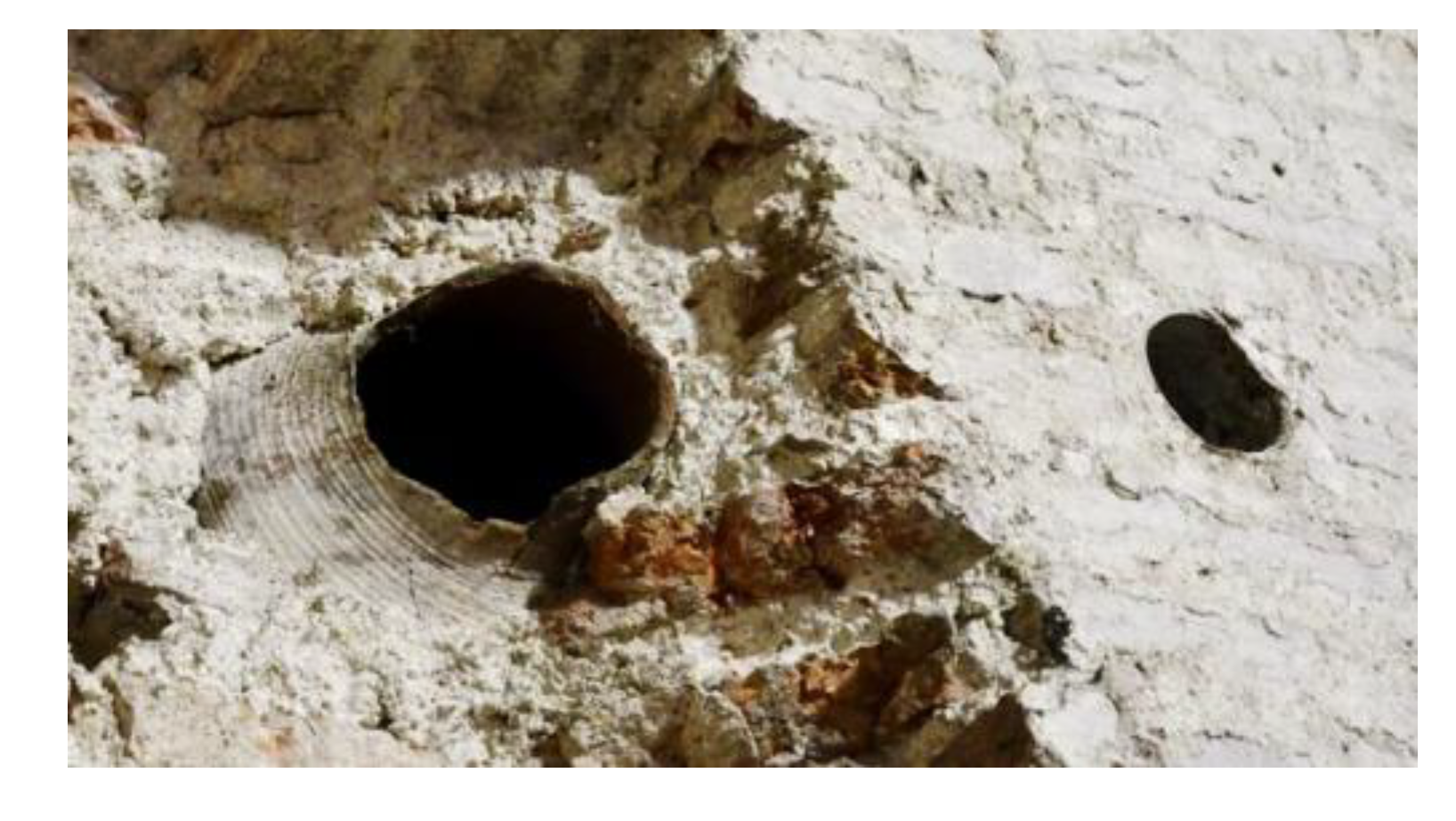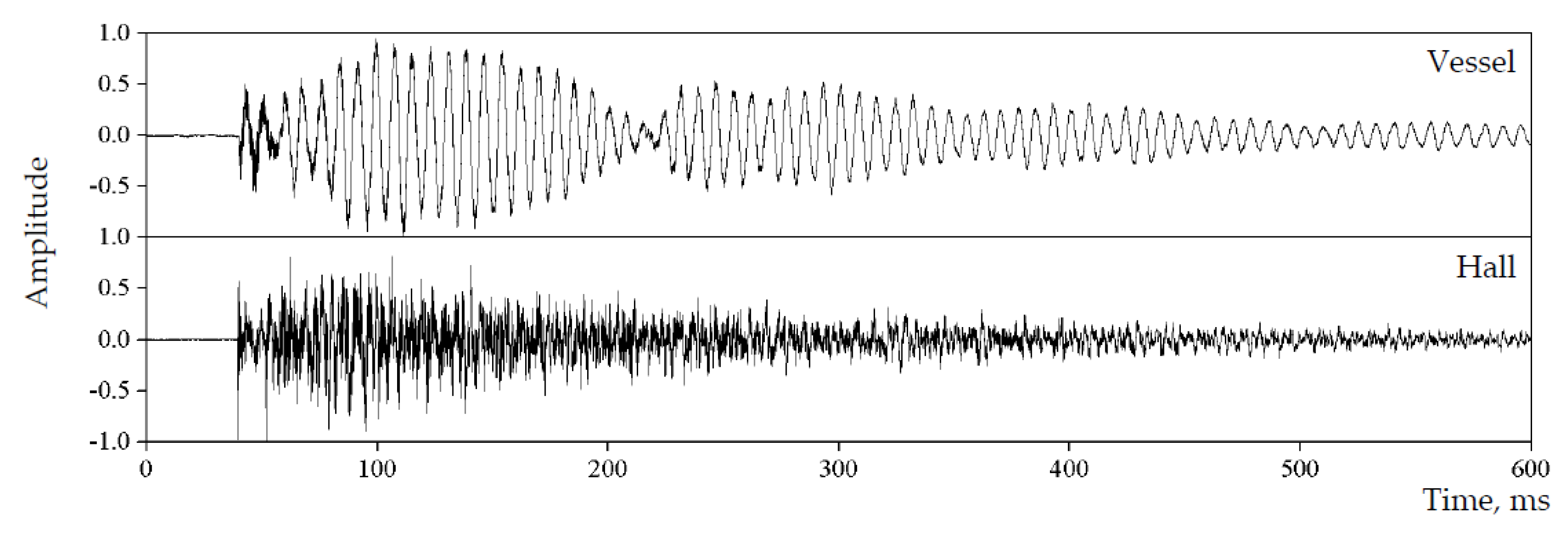Resonant Vessels in Russian Churches and Their Study in a Concert Hall
Abstract
1. Introduction
2. Russian Churches
2.1. St.Basil’s Cathedral
2.2. Churches in Pskov
2.3. Kalozha Church
3. Rachmaninov Concert Hall
3.1. Short History and Description
3.2. Resonators
3.3. Reverberation Time
3.4. C80 and EDT
4. Discussion
5. Conclusions
Funding
Acknowledgments
Conflicts of Interest
References
- Vitruvius. The Books on Architecture; Harvard University Press: Cambridge, UK, 1914. [Google Scholar]
- Valière, J.-C.; Palazzo-Bertholon, B.; Polack, J.-D.; Carvalho, P. Acoustic Pots in Ancient and Medieval Buildings: Literary Analysis of Ancient Texts and Comparison with Recent Observations in French Churches. Acta Acust. United Acust. 2013, 99, 70–81. [Google Scholar] [CrossRef]
- Arns, R.G.; Crawford, B.E. Resonant Cavities in the History of Architectural Acoustics. Technol. Culture 1995, 36, 104–135. [Google Scholar] [CrossRef]
- Palazzo-Bertholon, B.; Valière, J.-C. Archéologie du son: Les dispositifs de pots acoustiques dans les édifices anciens; Bulletin Monumental, Suppl. 5; Picard: Paris, France, 2012; ISBN 978-2-901837-41-1. [Google Scholar]
- Đorđević, Z.; Penezić, K.; Dimitrijević, S. Acoustic vessels as an expression of medieval music tradition in Serbian sacred architecture. Musicology 2017, 22, 105–132. [Google Scholar]
- Mijic, M.; Sumarac-Pavlovic, D. Acoustic resonators in Serbian orthodox churches. In Proceedings of the 3rd Forum Acusticum, Sevilla, Spain, 16–20 September 2002. [Google Scholar]
- Mijic, M.; Sumarac-Pavlovic, D. Analysis of contribution of acoustic resonators found in Serbian orthodox churches. Buid. Acoust. 2004, 11, 197–212. [Google Scholar] [CrossRef]
- Sü Gül, Z. Acoustical Impact of Architectonics and Material Features in the Lifespan of Two Monumental Sacred Structures. Acoustics 2019, 1, 493–516. [Google Scholar]
- Desarnaulds, V.; Loerincik, Y.; Carvalho, A. Efficiency of 13th-century Acoustic Ceramic Pots in Two Swiss Churches. In Proceedings of the conference NOISE-CON, Portland, ME, USA, 29–31 October 2001. [Google Scholar]
- Zakinthinos, T.; Skarlatos, D. The effect of ceramic vases on the acoustics of old Greek orthodox churches. Appl. Acoust. 2007, 68, 1307–1322. [Google Scholar] [CrossRef]
- Polack, J.-D. Acoustic potteries in southern Albania. In Proceedings of the Acoustics of Ancient Theatres Conference, Patras, Greece, 18–21 September 2011. [Google Scholar]
- Rappoport, P.A. Building the Churches of Kievan Russia; Routledge: London, UK, 1995. [Google Scholar]
- Strutt, J.W. The Theory of Sound; MacMillan and Co.: London, UK, 1877. [Google Scholar]
- Ingard, U. On the theory and design of acoustic resonators. J. Acoust. Soc. Am. 1953, 25, 1037–1061. [Google Scholar] [CrossRef]
- Tang, P.K.; Sirignano, W.A. Theory of generalized Helmholtz resonator. J. Sound Vib. 1973, 26, 247–262. [Google Scholar] [CrossRef]
- Howe, M.S. On the Helmholtz resonator. J. Sound Vib. 1976, 45, 427–440. [Google Scholar] [CrossRef]
- Carvalho, A.; Desarnaulds, V.; Loerincik, Y. Acoustic Behavior of Ceramic Pots Used in Middle Age Worship Spaces – A Laboratory analysis. In Proceedings of the 9th International Congress on Sound and Vibration (ICSV9), Orlando, FL, USA, 8–11 July 2002. [Google Scholar]
- Polychronopoulos, S.; Kougias, В.; Polykarpou, P.; Skarlatos, D. The Use of Resonators in Ancient Greek Theatres. Acta Acust. United Acust. 2013, 99, 64–69. [Google Scholar] [CrossRef]
- Bruel, V. Models of ancient sound vases. J. Acoust. Soc. Am. 2002, 112, 2333. [Google Scholar] [CrossRef]
- Karampatzakis, P.; Zafranas, V.; Polychronopoulos, S.; Karadedos, G. A study on Aristoxenus acoustic urns. In Proceedings of the Acoustics of Ancient Theatres Conference, Patras, Greece, 18–21 September 2011. [Google Scholar]
- Drocourt, D. L’acoustique au Moyen-Age: Les résonateurs de l’église Saint-Victor à Marseille. Archeologia 1971, 40, 28–35. [Google Scholar]
- Ousterhout, R. Master Builders of Byzantium; Princeton University Press: Princeton, NJ, USA, 1999. [Google Scholar]
- Malysheva, N.N.; Saracheva, T.G. Ceramic Vessels in the Architecture of Intercession Cathedral on the Moat in Moscow. Archeol. Hist. Pskov Pskov Land 2017, 32, 421–433. [Google Scholar]
- Official World Heritage List. Available online: http://whc.unesco.org/en/list/1523/ (accessed on 27 April 2020).
- Site dedicated to the scientist and architect Yu. Spegalsky. Available online: http://spegalsky.narod.ru/ (accessed on 27 April 2020).
- Stasov, V.V. Collected works 1847-1886; Stasulevich Printing House: St. Petersburg, Russia, 1894; pp. 71–94. [Google Scholar]
- Lapin, A.D. Sound absorption by a system of resonators with dissipation. Acoust. Phys. 2002, 48, 374–375. [Google Scholar] [CrossRef]
- Maurel, A.; Mercier, J.-F.; Pham, K.; Marigo, J.-J.; Ourir, A. Enhanced resonance of sparse arrays of Helmholtz resonators—Application to perfect absorption. J. Acoust. Soc. Am. 2019, 145, 2552–2560. [Google Scholar] [CrossRef]
- Pretlove, T. Helmholtz resonators for the new Russian orthodox church in London. Acoust. Bull. 1998, 23, 11–15. [Google Scholar]
- Kanev, N.G.; Livshits, A.Y.; Möller, H. Acoustics of the Great Hall of the Moscow State Conservatory after Reconstruction in 2010–2011. Acoust. Phys. 2013, 59, 361–368. [Google Scholar] [CrossRef]
- Beranek, L. Concert Halls and Opera Houses: Music, Acoustics, and Architecture, 2nd ed.; Springer: New York, NY, USA, 2004. [Google Scholar]
- Kanev, N.; Fadeev, A.; Livshits, A.; Nechaev, A.; Peretokin, A.; Rodenkov, V.; Shirgina, N. Acoustics of New and Renovated Chamber Music Halls in Russia. Proc. Mtgs. Acoust. 2017, 28, 015010. [Google Scholar]
- Hidaka, T.; Nishihara, N. Objective evaluation of chamber-music halls in Europe and Japan. J. Acoust. Soc. Am. 2004, 116, 357–372. [Google Scholar] [CrossRef]
- ISO 3382-1. Acoustics—Measurement of Room Acoustic Parameters. Part 1: Performance Rooms; International Organization for Standardization: Geneva, Switzerland, 2009. [Google Scholar]
- Cox, T.J.; Davies, W.J.; Lam, Y.W. The sensitivity of listeners to early sound field changes in auditoria. Acustica 1993, 79, 27–41. [Google Scholar]
- Martellotta, F. The just noticeable difference of center time and clarity index in large reverberant spaces. J. Acoust. Soc. Am. 2010, 128, 654–663. [Google Scholar] [CrossRef] [PubMed]
- Dorrego, F.S.; Vigeant, M.C. A study of the just noticeable difference of early decay time (EDT). Proc. Inst. Acoust. 2018, 40, 273–282. [Google Scholar]











| Parameter | Min | Max | Average |
|---|---|---|---|
| R, mm | 95 | 115 | 106 |
| r, mm | 75 | 95 | 85 |
| D, mm | 130 | 200 | 178 |
| l, mm | 198 | 300 | 252 |
| L, mm | 330 | 480 | 442 |
| V, liters | 1.8 | 4.2 | 3.1 |
| f0, Hz | 120 | 176 | 136 |
| Parameter | Frequency, Hz | Average Values | Abs. Differences | JND | |||
|---|---|---|---|---|---|---|---|
| Open | Close | [34] | [36,37] | ||||
| C80, dB | 125 (1/3 oct.) | −0.32 | −0.20 | 0.56 | 0.74 | 1.0 | 1.3 |
| 160 (1/3 oct.) | 0.48 | 0.34 | 0.68 | 0.92 | |||
| 500 (1/3 oct.) | −1.49 | −1.76 | 0.69 | 1.05 | |||
| 1000 (1/3 oct.) | −0.69 | −0.52 | 0.33 | 0.75 | |||
| 500 (1/1 oct.) | −1.88 | −1.83 | 0.43 | 0.68 | |||
| 1000 (1/1 oct.) | −0.84 | −0.68 | 0.24 | 0.42 | |||
| EDT, s | 125 (1/3 oct.) | 1.74 | 1.78 | 0.09 | 0.15 | 0.1 | 0.4 |
| 160 (1/3 oct.) | 1.78 | 1.87 | 0.10 | 0.15 | |||
| 500 (1/3 oct.) | 2.19 | 2.18 | 0.09 | 0.17 | |||
| 1000 (1/3 oct.) | 1.75 | 1.80 | 0.07 | 0.12 | |||
| 500 (1/1 oct.) | 2.20 | 2.19 | 0.10 | 0.14 | |||
| 1000 (1/1 oct.) | 1.84 | 1.82 | 0.08 | 0.13 | |||
© 2020 by the author. Licensee MDPI, Basel, Switzerland. This article is an open access article distributed under the terms and conditions of the Creative Commons Attribution (CC BY) license (http://creativecommons.org/licenses/by/4.0/).
Share and Cite
Kanev, N. Resonant Vessels in Russian Churches and Their Study in a Concert Hall. Acoustics 2020, 2, 399-415. https://doi.org/10.3390/acoustics2020023
Kanev N. Resonant Vessels in Russian Churches and Their Study in a Concert Hall. Acoustics. 2020; 2(2):399-415. https://doi.org/10.3390/acoustics2020023
Chicago/Turabian StyleKanev, Nikolay. 2020. "Resonant Vessels in Russian Churches and Their Study in a Concert Hall" Acoustics 2, no. 2: 399-415. https://doi.org/10.3390/acoustics2020023
APA StyleKanev, N. (2020). Resonant Vessels in Russian Churches and Their Study in a Concert Hall. Acoustics, 2(2), 399-415. https://doi.org/10.3390/acoustics2020023





